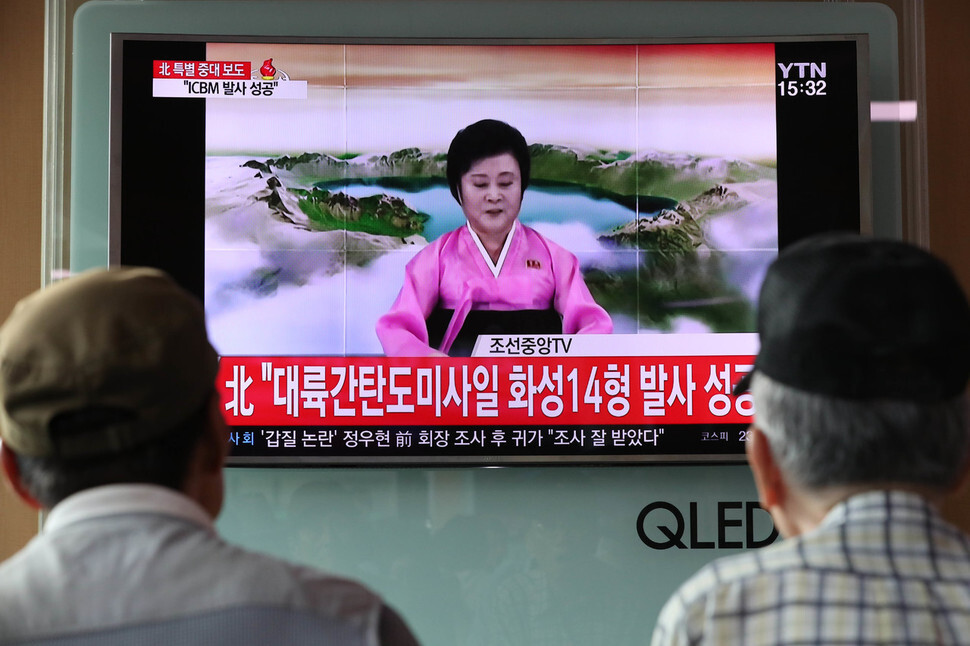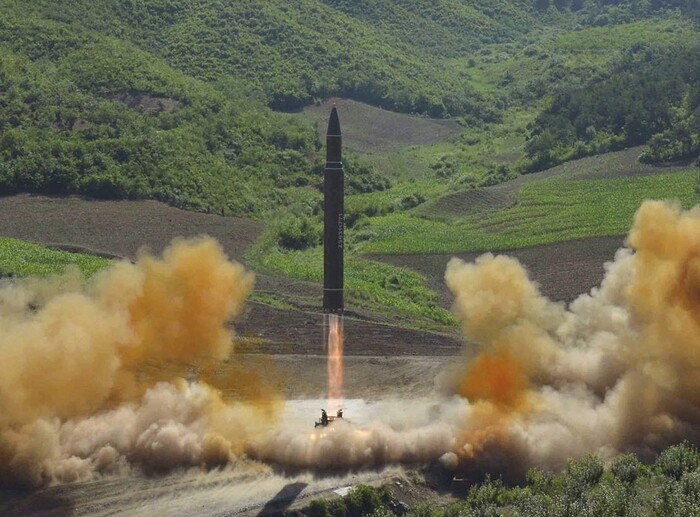hankyoreh
Links to other country sites 다른 나라 사이트 링크
[Reporter’s notebook] Just what can North Korea’s ICBMs do?

North Korea is an astonishing country. The CIA World Factbook's estimate of North Korea's 2015 GDP (based on purchasing power parity) is US$40 billion. This is 1/48 of South Korea's US$1.929 trillion and ranks the North as the world's 115th-largest economy. The per-capita GDP comes to a mere US$1,700, making North Korea one of the world's poorest countries. During the severe drought of the mid and late 1990s, deaths by starvation are estimated to have reached hundreds of thousands or perhaps even millions. The country survived that terrible time, but even now its children suffer from malnutrition and the North depends on support from the international community.
Yet just a few days ago, a country like that somehow managed to launch a state-of-the-art ICBM that can travel thousands of kilometers. That makes North Korea the sixth country in the world to possess such missiles. We would be at a loss to find another example of such extreme incongruity. Is it possible to fill such a huge gap with just the strong will of a "supreme leader" who says he will "fight head-to-head against American imperialism"?
North Korea's history of developing ballistic missiles goes back to the early 1980s. It is said that when the Soviet Union refused to provide the needed technology, the North Koreans bought old Soviet-made Scud-B missiles from Egypt, took them apart, analyzed them, and reverse engineered their own Scud-Bs. There is another theory that the Soviets actually did directly transfer the Scub-B technology. The North's missile program took a new turn after the Soviet Union collapsed in the early 1990s. Pyeongyang was able to recruit technicians from Soviet research centers that had lost funding from the central government and with their help, developed a variety of missiles, including the Rodong, Musudan, and Taepodong.

These missiles were all based on outdated technology from the 1950s and '60s. The Scud-B, Scud-C, Rodong and the Taepodong missiles and Eunha rocket launchers all used the old Soviet R-17 engine from the 1950s, and the Musudan, KN-08, and KN-14 had an R-27 engine, developed by the Soviets in the early 1960s. In some cases, the engines were modified for improved performance. Thus, there were clearly technological limits to the North's missile technology.
Recently, however, the North's missile program has been changing rapidly. It seems that it has dropped the old Soviet connection and started to develop its own new technology. The Pukkuksong-1 submarine-launched ballistic missile (SLBM) successfully test-launched last year and the Pukkuksong-2 use solid-fuel rockets rarely seen in North Korea before. The Hwasong-12 intermediate-range ballistic missile (IRBM) and the Hwasong-14 ICBM fired this year have liquid-fuel rockets, which are more commonly seen in the North, but their engines appear to be of a completely new design. Since March 2016, North Korea has publicly conducted four tests of rocket engines, all of which seem to have been developed with its own technology. Jeffrey Lewis, head of the East-Asia Program at the James Martin Center for Nonproliferation Studies, was quoted in the Washington Post on July 4 as saying that North Korea's new rocket engines were "the real thing," made with their own technology and not some copies or combinations of outdated Soviet engines.
All of this shows that missile development in the North is going through a transformation in quality, but the change is still in its early stages. The Pukkuksong missiles, the Hwasong-12, and the Hwasong-14 have been test-fired only once or twice each. It has not yet been confirmed that the North's ICBM can successfully reenter the atmosphere. Because ICBMs travel such long distances, even the slightest divergence in their early course can send them dozens of kilometers away from their target, and the level of North Korea's technology for high-precision missile guidance is another unknown at this point. Several more test launches will be needed. Nevertheless, it does not appear that it will be a very long time before the North has the capability to reach the contiguous United States with its ICBMs.
This is not to say that there is no way to stop it. The North has always conducted its missile tests openly, in contrast to its usual secrecy about the development of strategic weaponry. This seems to indicate that the missile program is not just a military program but also has a political purpose. It is a way of unifying the will of the people, and it sends a message to the outside world that North Korea will not surrender to sanctions imposed against it. At the same time, it hints at a willingness to compromise if the conditions are right. Now the ball is the the United States' court.
By Park Byong-su, senior staff writer
Please direct questions or comments to [english@hani.co.kr]

Editorial・opinion
![[Column] Has Korea, too, crossed the Rubicon on China? [Column] Has Korea, too, crossed the Rubicon on China?](https://flexible.img.hani.co.kr/flexible/normal/500/300/imgdb/original/2024/0419/9317135153409185.jpg) [Column] Has Korea, too, crossed the Rubicon on China?
[Column] Has Korea, too, crossed the Rubicon on China?![[Correspondent’s column] In Japan’s alliance with US, echoes of its past alliances with UK [Correspondent’s column] In Japan’s alliance with US, echoes of its past alliances with UK](https://flexible.img.hani.co.kr/flexible/normal/500/300/imgdb/original/2024/0419/2317135166563519.jpg) [Correspondent’s column] In Japan’s alliance with US, echoes of its past alliances with UK
[Correspondent’s column] In Japan’s alliance with US, echoes of its past alliances with UK- [Editorial] Does Yoon think the Korean public is wrong?
- [Editorial] As it bolsters its alliance with US, Japan must be accountable for past
- [Guest essay] Amending the Constitution is Yoon’s key to leaving office in public’s good graces
- [Editorial] 10 years on, lessons of Sewol tragedy must never be forgotten
- [Column] A death blow to Korea’s prosecutor politics
- [Correspondent’s column] The US and the end of Japanese pacifism
- [Guest essay] How Korea turned its trainee doctors into monsters
- [Guest essay] As someone who helped forge Seoul-Moscow ties, their status today troubles me
Most viewed articles
- 1[Column] The clock is ticking for Korea’s first lady
- 2Samsung barricades office as unionized workers strike for better conditions
- 3After 2 months of delayed, denied medical care, Koreans worry worst may be yet to come
- 4[Correspondent’s column] In Japan’s alliance with US, echoes of its past alliances with UK
- 5[Column] Has Korea, too, crossed the Rubicon on China?
- 6Hong Se-hwa, voice for tolerance whose memoir of exile touched a chord, dies at 76
- 7[Editorial] When the choice is kids or career, Korea will never overcome birth rate woes
- 8Constitutional Court rules to disband left-wing Unified Progressive Party
- 9Nearly 1 in 5 N. Korean defectors say they regret coming to S. Korea
- 10‘Right direction’: After judgment day from voters, Yoon shrugs off calls for change